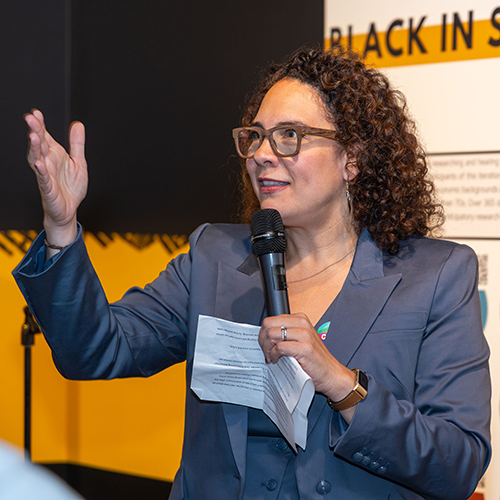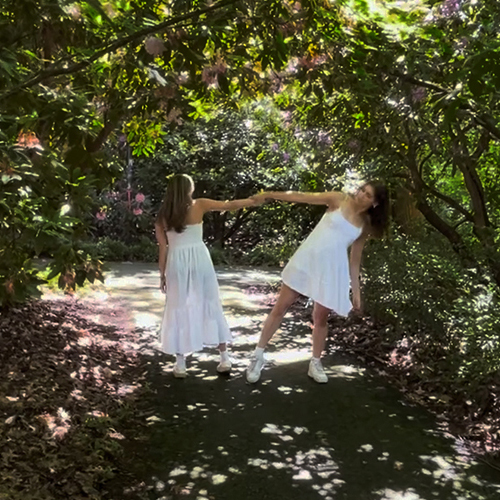Within minutes of entering the Willapa National Wildlife Refuge in southwest Washington, visitors may find themselves perched on a mud-loving marine worm while picnicking on the back of a dragonfly.

The worm and dragonfly are a picnic table and bench created by Gary Carpenter, one of five undergraduates commissioned to create sculptures for the refuge through a public art course (ART 332) offered by the UW School of Art.
The sculptures, installed in September, represent the second stage of the Willapa Bay Interpretive Trail project. The project uses artwork, rather than traditional signage, to teach about the species and biodiversity of the refuge.
It was scientist Charlie Stenvall who proposed the idea for including art in the refuge. Stenvall is project leader of the Willapa National Wildlife Refuge Complex, home to numerous threatened and endangered species including migratory birds and fish, insects, amphibians, and mammals.
“We had interpretive panels in the refuge, and I commented to someone that interpretive panels bore me to death,” recalls Stenvall. “I said that there must be a better way to engage the public.” Staffer Jean Harrison suggested using art instead, and Stenvall ran with the idea. He and interpretive specialist John Ivie contacted John Young, director of the School of Art’s Public Art Program, to discuss commissioning students to create artworks. That was seven years ago.
The first art project had both sculptural and architectural elements, including a serpentine boardwalk that guides visitors along a restored stream where salmon spawn. “Once that project was completed, it made me realize how much more we could do,” says Stenvall. He and Ivie contacted Young again last fall, proposing a second phase and providing a $50,000 budget for the art commissions, including private support from the Friends of Willapa National Wildlife Refuge.

The project became the focus of Young’s spring quarter public art course. The class traveled to Willapa Bay to tour the trail and talk with refuge staff. Then each student prepared a minimum of five ideas, which they presented to refuge staff for feedback. As with all public art, durability was a concern. The works would have to withstand salt water, high winds, and public use. But equally important was accuracy in the depiction of species.
“The staff at Willapa Bay wouldn’t let us stray one bit from getting the biology right,” says Young. “The students had to represent species that are right there, not ten miles away.” An amused Stenval adds that through this process students “learned a lot about some pretty strange species, like coral fungus and warty jumping slugs.”
After their first presentation, each student fine-tuned one or two ideas and prepared models, schematics, and budgets, which they presented to a seven-member selection panel at the end of spring quarter. “There was a lot of nervous energy that day,” recalls Carpenter. “Everyone was so keyed up and enthusiastic about their ideas. And the biologists were great. They were very supportive.”

For most of the 20 students in the class, their involvement with the project ended with that presentation. But for the five who were selected, it was just the beginning. They spent long summer days in the UW’s Ceramic and Metal Arts Studio completing their artworks, with guidance from Young and faculty colleague Mike Magrath. The students’ learning curve was steep as they tackled unfamiliar techniques—welding, bronze casting, terrazzo—and learned to work within a budget. “This was not an academic exercise,” says Young. “This was real.”
Kristen Boraca created a 15-foot-tall steel sculpture with birds spiraling skyward to suggest bird migration. “My first idea was to have birds on the ends of metal poles, jutting out everywhere,” says Boraca. “I got a harsh critique of that one. I was told they looked like skewered birds.” She laughs, adding, “Clearly I had to revise.”
The biggest challenge, says Boraca was ensuring the piece’s structural integrity. “Through the whole building process, I was fighting gravity,” she explains. “It’s a huge structure without much to support it.” Graduate teaching assistant Noah Grussgott helped Boraca throughout the construction process.
For Jacqye Jones, installation of her artwork was a family affair. Jones cast 38 small sculptures in bronze, each depicting a species found at the refuge, including a newly discovered tailed frog that is unique to Willapa Bay. The sculptures are embedded in mortared stone; Jones’ family helped dig holes and pour concrete for the work. “My piece is a representation of what happens horizontally in the river, but I’ve depicted it vertically,” she says, explaining that the site’s murky water makes viewing the actual species difficult.

Becca Weiss created 14 directional signs for the refuge, with birds serving as the “arrows.” Perched at the end of long curved rods that sway slightly in the breeze, each bird is painted to represent a common migratory species found at the refuge. Their beaks serve as directional pointers.
While the others focused on animal species at the refuge, Allison Blevins tackled something more unexpected: oil. From the boardwalk over the marshland, visitors can see oil floating on the surface of the water. Many mistakenly believe that it is runoff from the parking lot nearby. The oil is actually from plants that are breaking down. You can tell the difference, says Blevins, because plant oils break into shards when disturbed, while petroleum swirls.
To help visitors to understand that the oil is the result of a natural process, Blevins created bronze shards that represent the plant oils. Text etched into the bronze explains the phenomenon. The shards are set in the boardwalk.

Then there’s Gary Carpenter’s dragonfly picnic table, surrounded by three benches depicting a blue nereis, a giant water bug, and a juga snail, all topped with colorful terrazzo. “It’s been an amazing learning journey,” says Carpenter. “As an undergraduate, to be able to leave the University with something like this in my portfolio is amazing.”
No one is more pleased to see the artworks installed than Stenvall. The art has brought more visitors to the trail, he says, which translates to more people learning about the refuge. Stenvall is already looking forward to a third round of artwork commissions in the future.
“Science is constantly being updated, creating opportunities for art to interpret that,” he says. “I see this as a living art trail. It’s not meant to be static.”
More Stories

Democracy by the Numbers
Mathematics and Democracy, an undergraduate mathematics course, explores the role of math in many aspects of democracy, from elections to proportional representation.

Interrupting Privilege Starts with Listening
Personal stories are integral to Interrupting Privilege, a UW program that leans into difficult intergenerational discussions about race and privilege.

Dancing Across Campus
For the dance course "Activating Space," students danced in public spaces across the University of Washington's Seattle campus this spring.